Thermo-Mechanical Coupling Model for Energy Piles: Dynamic Interface Behavior and Sustainable Design Implications
Abstract
1. Introduction
2. Temperature Variation Model of Pile–Soil Interface of Single Energy Pile
2.1. Introduction of Numerical Model of Pile–Soil Interface
2.2. Boundary Conditions and Mesh Design
2.3. Results Analysis
3. Analytical Solution for the Temperature Field of Soil Surrounding Energy Piles
3.1. Heat Transfer Model of Energy Piles
3.2. Limitations of the Heat Transfer Model of Energy Piles
4. Calculation of Settlement for a Single Energy Pile
4.1. Control Equation for a Single Energy Pile
4.2. Establishment of the Mechanical Model for the Pile Side
4.3. Establishment of the Mechanical Model for the Pile End
4.4. Settlement Calculation Procedure for a Single Energy Pile
- 1.
- Discretize the pile into n segments and assign node numbers from 0 to n, with the pile tip node designated as n + 1.
- 2.
- Apply a pile top load Q and initially estimate the displacements of two pile nodes, S1 z and S2 z, setting them to minimal values.
- 3.
- Compute the shaft friction τ1 z and τ2 z for these nodes using the pile shaft load transfer model.
- 4.
- Assuming linear variation in the axial force within the pile segment, the elastic compression Sc of segment 1 is given by:
- 5.
- Adjust the displacement at node 2 as:
- 6.
- Compare the adjusted displacement S2′ z with the initially assumed displacement S2 z. If the absolute difference is less than 1 × 10−6, adopt S2′ z as the displacement at node 2; otherwise, repeat steps 3–5 until the difference is less than 1 × 10−6.
- 7.
- Calculate the displacements for the remaining pile nodes.
- 8.
- Using the node displacements calculate the pile shaft friction for each pile segment and sum them to obtain the total pile shaft friction Qz.
- 9.
- Using the pile tip load transfer model and the calculated displacement of the pile tip node Sn z, determine the pile tip load Qb.
- 10.
- Calculate the total bearing capacity of the pile Q’:
- 11.
- Vary the pile top load Q and repeat steps 2–10 to generate a series of pile top displacements and their corresponding loads, establishing the load-settlement relationship.
5. Validation of Single Energy Pile Model
5.1. Case Study 1: Friction-Type Energy Pile in Kunshan, China
5.2. Case Study 2: PHC Energy Piles at Henan Zhoukou Normal College Sports Complex, China
6. Conclusions and Future Work
Author Contributions
Funding
Institutional Review Board Statement
Informed Consent Statement
Data Availability Statement
Acknowledgments
Conflicts of Interest
Abbreviations
| Tpc | temperature at the pile–soil interface; |
| ΔT | temperature variation in the energy pile; |
| q | intensity of the heat source; |
| q’ | modified intensity of the heat source; |
| ΔTQ | temperature variation in the soil surrounding the energy pile; |
| S(z) | displacement at depth z along the pile; |
| P(z) | axial force at depth z along the pile; |
| τz | pile shaft shear stress; |
| ωs | relative displacement between the energy pile and the soil; |
| rm | radius of influence around the pile shaft; |
| a | pile–soil interface failure shear stress; |
| b | ratio of the initial shear stiffness to the failure shear stress; |
| τf | failure shear stress; |
| τu | ultimate shear stress at the pile shaft; |
| ks0 | initial shear stiffness of the pile–soil interface; |
| τunew | ultimate shear stress at the pile–soil interface, accounts for both the self-weight stress of the surrounding soil and the additional stress induced by temperature changes; |
| σrz | radial thermal stress induced by temperature changes in the energy pile; |
| Δz | deformation in the z-direction due to temperature changes in the energy pile; |
| ΔV | volume change in the energy pile due to temperature variations; |
| Δr | radial deformation of the energy pile under temperature influence; |
| p | the pile tip resistance; |
| a’ | model parameter; |
| b’ | model parameter; |
| ksb | initial stiffness of the soil at the pile end; |
| pbu | ultimate bearing capacity per unit area of the soil at the pile end; |
| Nc | bearing capacity factor; |
| average vertical pressure on the lateral surface of the pile tip; | |
| NpV | bearing capacity factor corresponds to Vesic’s pile tip failure mode; |
| NpJ | bearing capacity factor corresponds to Janbu pile tip failure mode |
| Sc | the elastic compression; |
| Q’ | total bearing capacity of the pil. |
References
- Ding, X.; Peng, C.; Wang, C.; Kong, G. Heat transfer performance of energy piles in seasonally frozen soil areas. Renew. Energy 2022, 190, 903–918. [Google Scholar] [CrossRef]
- Park, S.; Lee, D.; Choi, H.J.; Jung, K.; Choi, H. Relative constructability and thermal performance of cast-in-place concrete energy pile: Coil-type GHEX (ground heat exchanger). Energy 2015, 81, 56–66. [Google Scholar] [CrossRef]
- Zarrella, A.; De Carli, M.; Galgaro, A. Thermal performance of two types of energy foundation pile: Helical tube and triple U-tube. Appl. Therm. Eng. 2013, 61, 301–310. [Google Scholar] [CrossRef]
- Murphy, K.; Gao, J.; Olgun, C.G. Performance and sustainability of energy piles. Renew. Sustain. Energy Rev. 2014, 35, 1–12. [Google Scholar]
- Hamada, Y.; Hirose, S.; Nakamura, H. Long-term performance of energy piles in different climatic conditions. Geothermics 2021, 89, 101882. [Google Scholar]
- Laloui, L.; Loria, A.F.R. Thermo-mechanical analysis of energy piles: A review of critical aspects and challenges. Geomech. Energy Environ. 2019, 19, 100127. [Google Scholar]
- Fan, Z.; Parashar, R. Analytical solutions for a wellbore subjected to a non-isothermal fluid flux: Implications for optimizing injection rates, fracture reactivation, and EGS hydraulic stimulation. Rock Mech. Rock Eng. 2019, 52, 4715–4729. [Google Scholar] [CrossRef]
- Suryatriyastuti, M.; McCartney, J.S.; Stewart, M.A. Thermal and mechanical behavior of energy piles in unsaturated silt. J. Geotech. Geoenviron. Eng. 2012, 138, 1069–1082. [Google Scholar]
- Zhang, B.; Wang, J.; Wang, R. Analytical solutions for the thermo-mechanical behavior of energy piles. Renew. Energy 2018, 116, 196–208. [Google Scholar]
- Di Donna, A.; Ferrari, A.; Laloui, L. Experimental investigations of the soil-concrete interface: Physical mechanisms, cyclic mobilisation and behaviour at different temperatures. Can. Geotech. J. 2016, 53, 659–672. [Google Scholar] [CrossRef]
- Loria, A.F.R.; Laloui, L. Group action effects caused by various operating energy piles. Géotechnique 2018, 68, 834–841. [Google Scholar] [CrossRef]
- Sarkar, P.; Pant, P. Nanavati Physical phenomena during nanoindentation deformation of amorphous glassy polymers. Polymer 2024, 312, 295–307. [Google Scholar] [CrossRef]
- Wang, S.D.; Du, H.; Wei, G.; Peng, P.; Xuan, P. Experimental modification of the internal solitary wave force exerted on a horizontal transverse cylinder due to wave-flow and vortex shedding. Ocean Eng. 2023, 269, 113513. [Google Scholar] [CrossRef]
- Kim, B.T.; Kim, N.K.; Lee, W.J.; Kim, Y.S. Experimental load-transfer curves of laterally loaded piles in Nak-Dong River sand. J. Geotech. Geoenviron. Eng. 2004, 130, 416–425. [Google Scholar]
- Behbehani, F.; McCartney, J.S. Energy pile groups for thermal energy storage in unsaturated soils. Appl. Therm. Eng. 2022, 215, 119028. [Google Scholar] [CrossRef]
- Stewart, M.A.; McCartney, J.S. Strain distributions in centrifuge model energy foundations. In Proceedings of the GeoCongress 2012: State of the Art and Practice in Geotechnical Engineering, Oakland, CA, USA, 25–29 March 2012; pp. 4376–4385. [Google Scholar]
- Gao, J.; Zhang, R.; Liu, J.; Li, K.; Yang, J. Numerical and experimental assessment of thermal performance of vertical energy piles: An application. Appl. Energy 2008, 85, 901–910. [Google Scholar] [CrossRef]
- Köhler, J.; Jäschke, M.; Weber, M. Thermal performance of energy piles in different climates. Renew. Energy 2017, 114, 160–172. [Google Scholar]
- Di Donna, A.; Laloui, L. Advancements in geotechnical design of energy piles. In Proceedings of the International Workshop on Geomechanics and Energy—The Ground as Energy Source and Storage, Lausanne, Switzerland, 26–28 November 2013; pp. 26–28. [Google Scholar]
- Liu, J.; Zhang, Q.; Xiao, K.; Cui, W.; Liu, Z. Study on the thermo-mechanical response of a single energy pile in pile groups. Structures 2025, 71, 108013. [Google Scholar] [CrossRef]
- Liu, S.; Zhang, Q.; Liu, J.; Cui, W.; Yu, X. A simple method for predicting the response of single energy pile considering temperature variation of pile-soil interface. Int. J. Geomech. 2023, 23, 04022293. [Google Scholar] [CrossRef]
- Li, Q.; Zheng, M.; Qiao, L.; Sui, Z. Transient heat transfer model of a three-dimensional spiral heat source in an energy pile. Chin. J. Eng. 2021, 43, 1569–1576. [Google Scholar]
- Chiasson, A.; O’Connell, A. New analytical solution for sizing vertical borehole ground heat exchangers in environments with significant groundwater flow: Parameter estimation from thermal response test data. HVACR Res. 2011, 17, 1000–1011. [Google Scholar] [CrossRef]
- Côté, J.; Konrad, J.M. A generalized thermal conductivity model for soils and construction materials. Can. Geotech. J. 2005, 42, 443–458. [Google Scholar] [CrossRef]
- Wu, D.; Liu, H.; Kong, G.; Wang, C.; Che, P. Study on bearing characteristics of energy piles with embedded and tied buried tubes. Acta Energiae Solaris Sin. 2017, 38, 1109–1116. (In Chinese) [Google Scholar]
- Randolph, M.F.; Wroth, C.P. Analysis of vertical deformation of vertically loaded piles. Int. J. Rock Mech. Min. Sci. Geomech. Abstr. 1978, 104, 1465–1488. [Google Scholar]
- Liu, J.H. Study on Bearing Characteristics of Energy Piles Considering Temperature Variation Effects at the Pile-Soil Interface. Master’s Thesis, Shandong University, Jinan, China, June 2022. (In Chinese). [Google Scholar]
- Faizal, M.; Bouazza, A.; Haberfield, C.; McCartney, J.S. Axial and radial thermal responses of a field-scale energy pile under monotonic and cyclic temperature changes. J. Geotech. Geoenviron. Eng. 2018, 144, 04018072. [Google Scholar] [CrossRef]
- Chang, H.; Zhu, W.; Wang, Y.; Gu, F. Mechanical characteristics of energy piles under temperature load. Chin. Sci. Pap. 2022, 17, 660–666. (In Chinese) [Google Scholar]
- Vesic, A.S. Analysis of ultimate loads of soil mechanics and foundations. J. Soil Mech. Found. Eng. 1973, 99, 45–73. [Google Scholar] [CrossRef]
- Jiang, G.; Li, R.; Wang, H.; Chen, G.; Lu, H.; Shao, D. Analysis of the thermal-mechanical coupling performance of friction-type energy piles. Chinses J. Rock Mech. Eng. 2019, 38, 2525–2534. (In Chinese) [Google Scholar]
- Ren, L.; Ren, J.; Kong, G.; Liu, H. Field tests on thermal response and bearing performance of PHC energy piles under cyclic heating and cooling. Rock Soil Mech. 2021, 42, 529–536+546. (In Chinese) [Google Scholar]


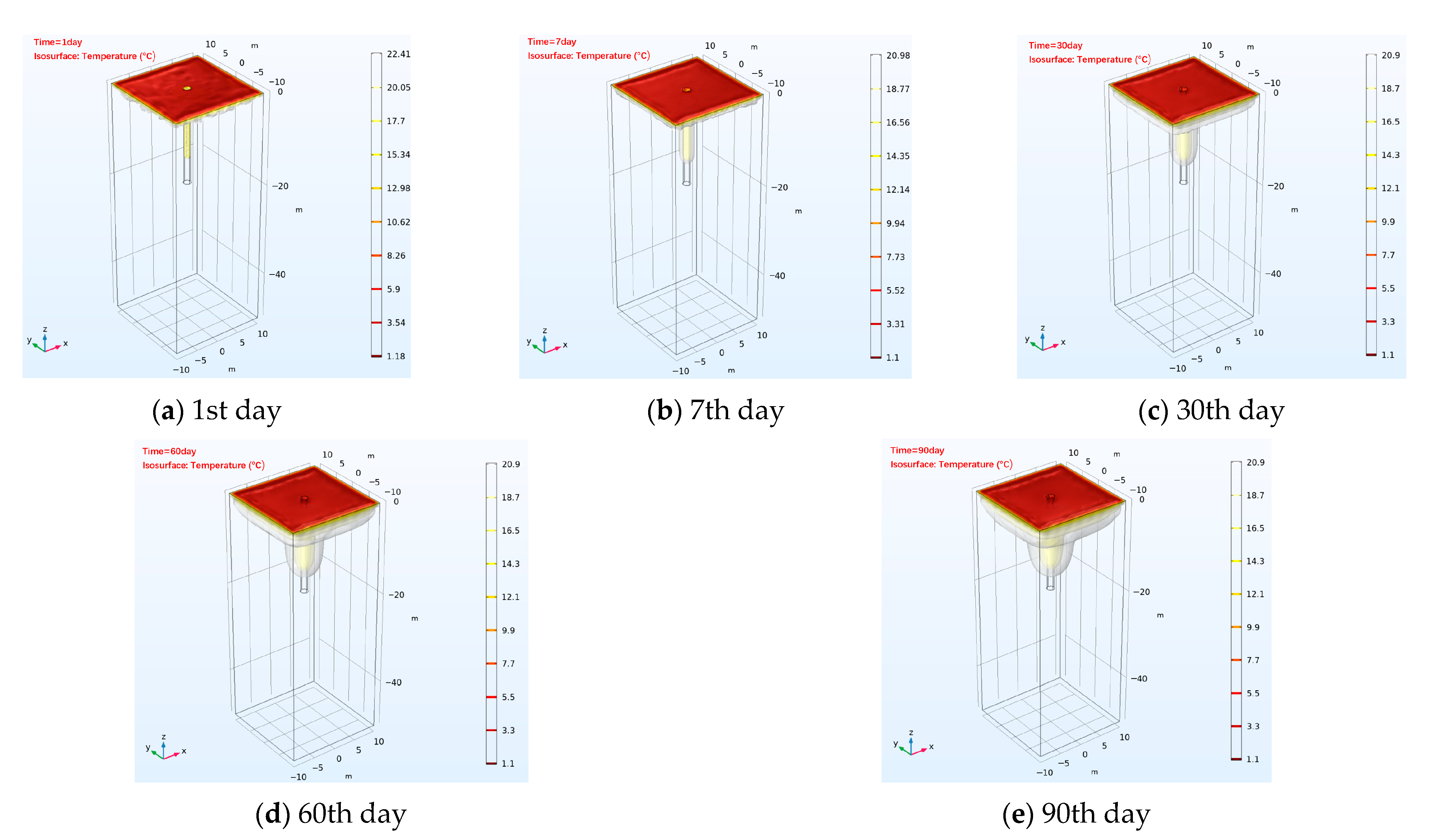
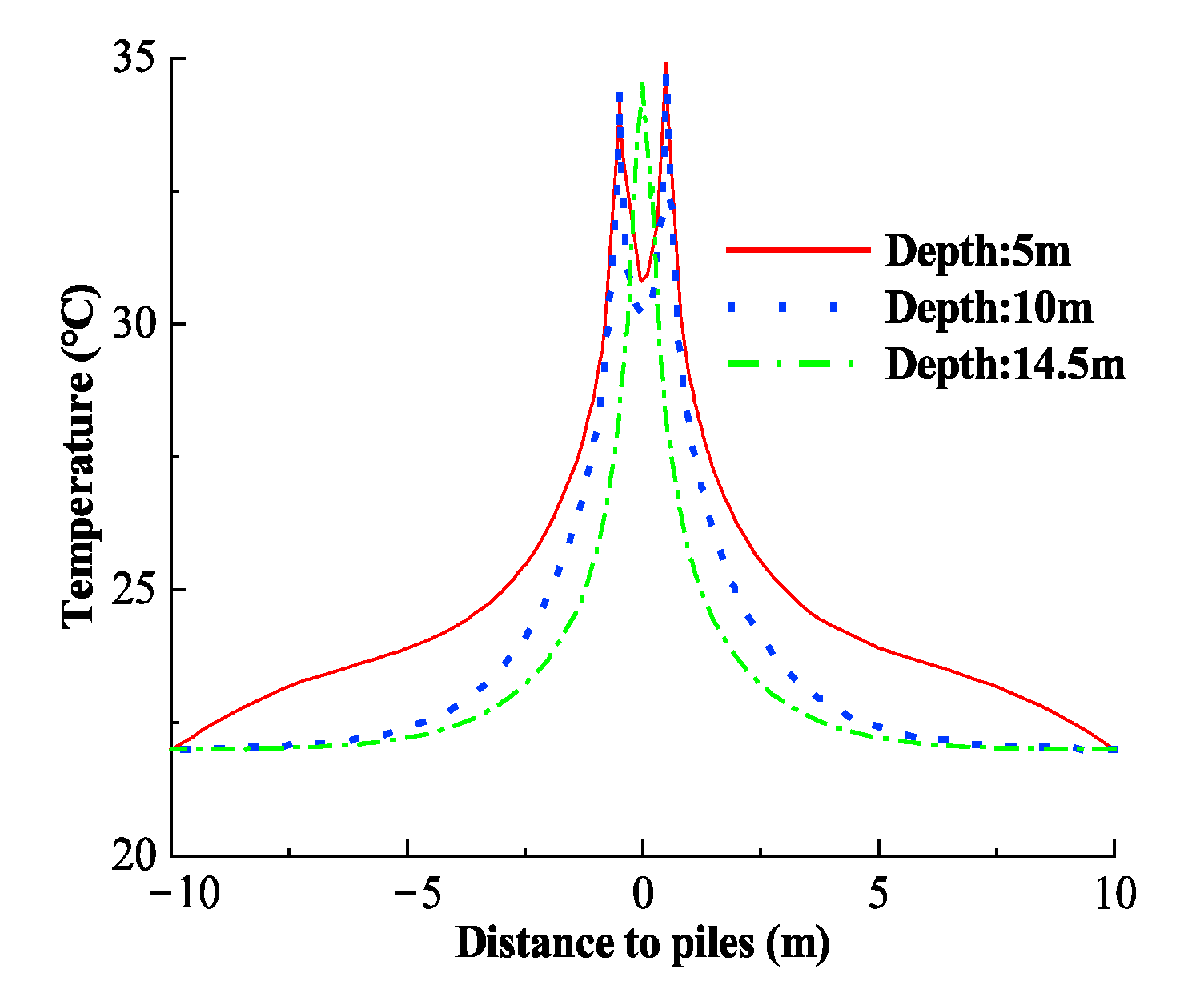





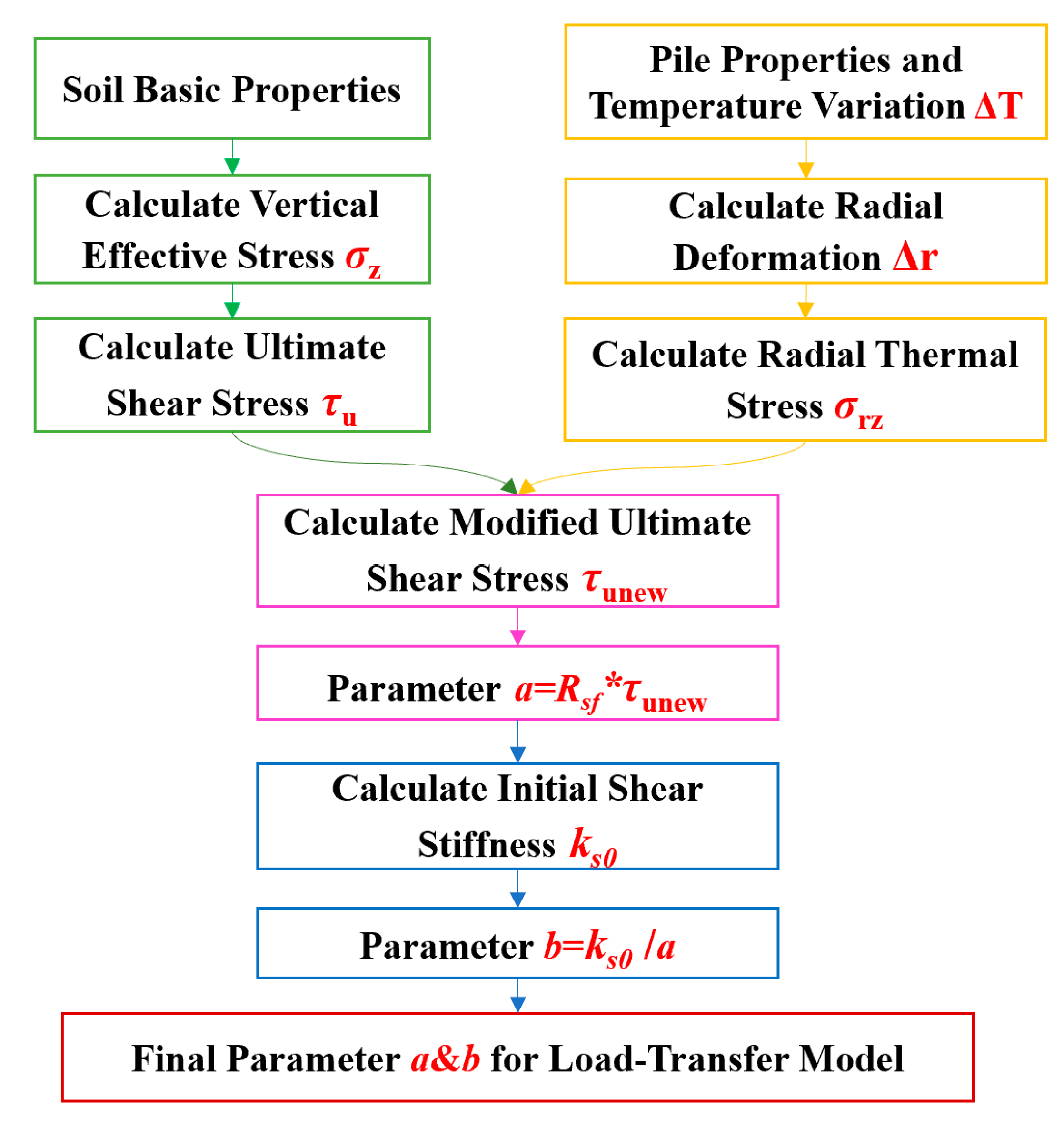
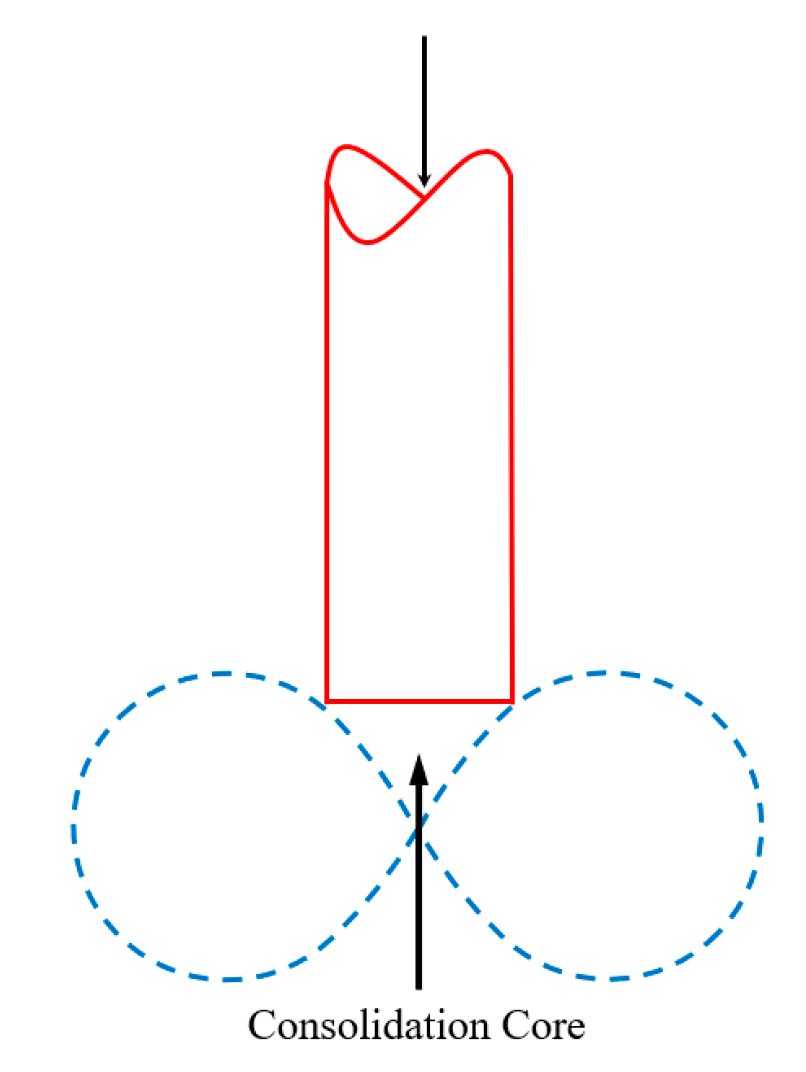


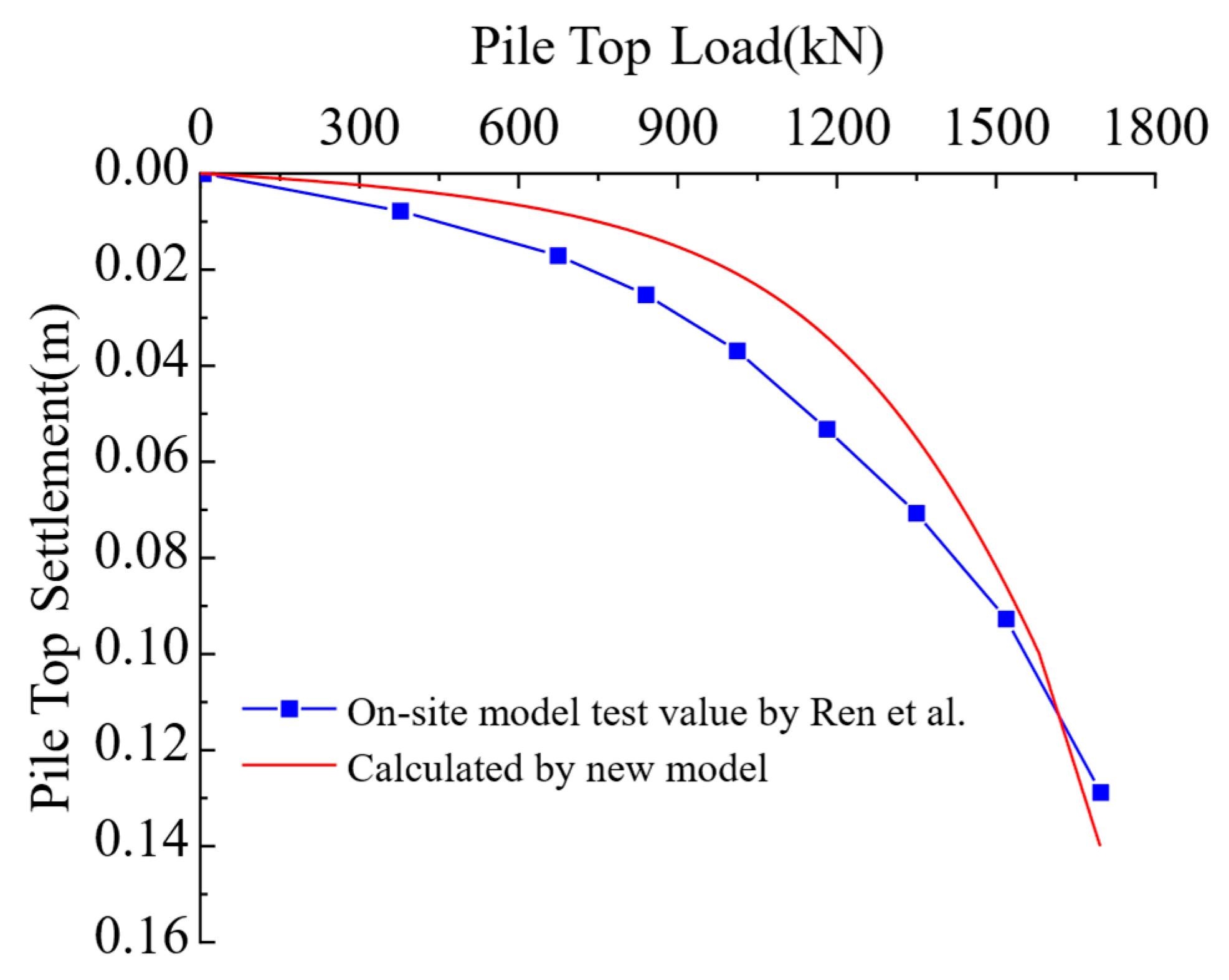
| Material | Density [kg/m3] | Constant Pressure Heat Capacity [J/(kg·K)] | Thermal Conductivity [W/(m·K)] |
|---|---|---|---|
| Water (exchange fluid) | 1000 | 4200 | 0.62 |
| Sandy soil (soil around pile) | 1730 | 1200 | 1.68 |
| Concrete (energy pile) | 2500 | 960 | 1.92 |
| Heat exchange tube | 7870 | 440 | 50.0 |
| Pile Length (m) | Pile Diameter (m) | Elastic Modulus (GPa) | Density (kg/m3) | Poisson’s Ratio | Coefficient of Thermal Expansion (m/°C) |
|---|---|---|---|---|---|
| 40 | 0.6 | 30 | 2500 | 0.2 | 1 × 10−5 |
| Number | Soil Layer | Thickness (m) | Density (kg/m3) | Internal Friction Angle (°) | Elastic Modulus (MPa) | Pile–Soil Friction Coefficient | Poisson’s Ration | Cohesion (kPa) |
|---|---|---|---|---|---|---|---|---|
| 1 | Plain fill | 3.0 | 1800 | 11.6 | 28 | 0.2 | 0.35 | 9 |
| 2 | Topsoil | 2.0 | 1800 | 11.6 | 28 | 0.2 | 0.35 | 9 |
| 3 | Silty clay | 1.5 | 1830 | 12.8 | 25 | 0.2 | 0.35 | 22 |
| 4 | Silty clay with silt | 2.0 | 1830 | 10.0 | 15 | 0.2 | 0.40 | 13 |
| 5 | Silty clay | 5.0 | 1940 | 15.0 | 80 | 0.2 | 0.35 | 42 |
| 6 | Silt with fine sand | 6.0 | 1840 | 25.1 | 100 | 0.3 | 0.30 | 8 |
| 7 | Fine Sand with silt | 6.0 | 1860 | 27.1 | 140 | 0.3 | 0.30 | 6 |
| 8 | Silt | 2.5 | 1810 | 22.1 | 120 | 0.3 | 0.30 | 9 |
| 9 | Silt | 12.0 | 1840 | 25.2 | 200 | 0.3 | 0.30 | 8 |
| Pile Length (m) | Pile Diameter (m) | Elastic Modulus (GPa) | PHC Tube Wall Thickness (m) | Poisson’s Ratio | Coefficient of Thermal Expansion (m/°C) |
|---|---|---|---|---|---|
| 12 | 0.4 | 38 | 0.95 | 0.2 | 1 × 10−5 |
| Number | Soil Layer | Thickness (m) | Density (kg/m3) | Internal Friction Angle (°) | Elastic Modulus (MPa) | Pile–Soil Friction Coefficient |
|---|---|---|---|---|---|---|
| 1 | Mixed fill soil | 1.1 | 19.3 | 20.8 | 8.24 | 0.5 |
| 2 | Silt | 1.4 | 19.8 | 18.6 | 9.88 | 0.5 |
| 3 | Silty clay | 1.8 | 17.9 | 9.7 | 5.33 | 0.5 |
| 4 | Silt | 1.4 | 19.4 | 7.4 | 3.50 | 0.5 |
| 5 | Silty clay | 3.5 | 18.2 | 10.8 | 5.85 | 0.5 |
| 6 | Silty clay | 1.5 | 18.6 | 15.8 | 8.42 | 0.5 |
| 7 | Silty sand | 1.4 | 19.3 | 13.2 | 18.00 | 0.5 |
Disclaimer/Publisher’s Note: The statements, opinions and data contained in all publications are solely those of the individual author(s) and contributor(s) and not of MDPI and/or the editor(s). MDPI and/or the editor(s) disclaim responsibility for any injury to people or property resulting from any ideas, methods, instructions or products referred to in the content. |
© 2025 by the authors. Licensee MDPI, Basel, Switzerland. This article is an open access article distributed under the terms and conditions of the Creative Commons Attribution (CC BY) license (https://creativecommons.org/licenses/by/4.0/).
Share and Cite
Cui, C.; Liu, Z.; Liu, J.; You, Y. Thermo-Mechanical Coupling Model for Energy Piles: Dynamic Interface Behavior and Sustainable Design Implications. Buildings 2025, 15, 3984. https://doi.org/10.3390/buildings15213984
Cui C, Liu Z, Liu J, You Y. Thermo-Mechanical Coupling Model for Energy Piles: Dynamic Interface Behavior and Sustainable Design Implications. Buildings. 2025; 15(21):3984. https://doi.org/10.3390/buildings15213984
Chicago/Turabian StyleCui, Chunyu, Zhongren Liu, Jinghang Liu, and Yang You. 2025. "Thermo-Mechanical Coupling Model for Energy Piles: Dynamic Interface Behavior and Sustainable Design Implications" Buildings 15, no. 21: 3984. https://doi.org/10.3390/buildings15213984
APA StyleCui, C., Liu, Z., Liu, J., & You, Y. (2025). Thermo-Mechanical Coupling Model for Energy Piles: Dynamic Interface Behavior and Sustainable Design Implications. Buildings, 15(21), 3984. https://doi.org/10.3390/buildings15213984





